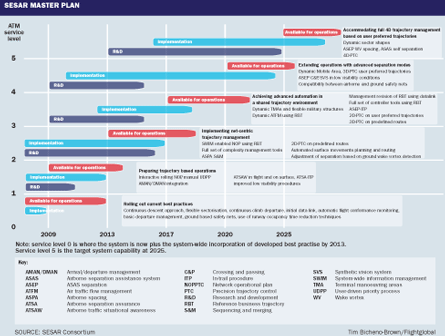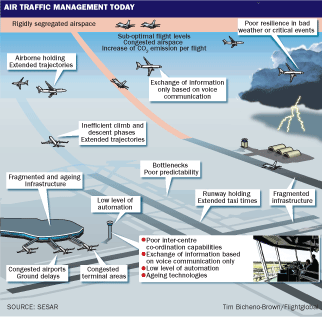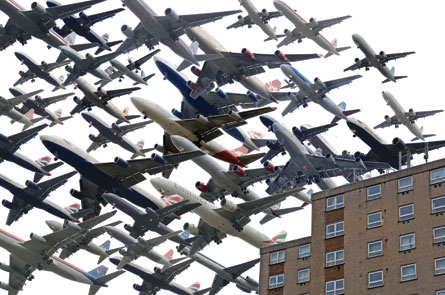By the end of this year, the first air traffic management measures identifiable as early moves toward a Single European Sky are due to be rolled out. But no one will notice, because the procedures will not be radical and will be introduced route by route rather than network-wide.
The purpose of the SES is to make the air traffic management system cost-efficient and able to cope with predicted increases in demand. The current fragmented set-up results in aircraft flying longer routes than necessary, increasing fuel consumption and greenhouse gas emissions.
Given the SES project's multinational character, complexity and the political, social and technological changes that have to be embraced to make it happen, it has progressed reasonably quickly. It also appears to be largely on track at, although some air navigation service providers are struggling to raise all aspects of their game to current "best practice" levels. This is supposed to be the starting point for the real SES surge, which is planned to begin in 2013 (see Service Level 0 in Master Plan diagram).

The Brussels-based SESAR Joint Undertaking is responsible for co-ordinating the project, and Florian Guillermet, its chief programme officer, is optimistic. "This partnership is working," he says. "It is a daily reality." The project has the necessary political buy-in, he says, and the essential governance is in place. Part of the formula to win buy-in, says Guillermet, is that a business case is built for every stage of every project before it can be approved.
Richard Deakin, head of the UK's semi-privatised ATM provider NATS, is more sceptical. He describes the future challenges for Europe as "technical, political and social". The SESAR Joint Undertaking, he says, "is providing the bricks to build the new house, but no one has spoken to the architect". Deakin believes the whole edifice, if it is to be built, cannot be constructed without "commonly agreed principles". Guillermet, on the other hand, believes those principles have been established, and says individual partners will not be allowed to interpret them as they see fit.

Deakin says the six largest and most influential air navigation service providers - those of France, Germany, Italy, Spain, Sweden and the UK, known as the A6 - are trying to agree those principles. Technology and operational objectives have been agreed, but the problem is how to turn the ideas into reality when the providers are ultimately controlled by politicians in 30 or so sovereign states, and the necessary changes will entail major social disturbance.
 |
|---|
©Rex FeaturesAir traffic management alone cannot solve capacity shortage problems at Europe's major hub airports |
Meanwhile, the master plan covers development and deployment up to 2025, during which time all the air navigation service providers and airports in Europe will, theoretically, advance in harmony at the same rate using the same route map. The chart is divided vertically into performance objectives referred to as ATM service levels, from SL 0 in 2008 to SL 5, which will become operational in 2025. The objectives for each service level are described in operational performance terms, with time built in for R&D and for validating the technological and human means by which they can be implemented.
Despite the fact that the SES project has a firm political and legal foundation, continuing political will is vital for it to succeed. The original two-year SES definition phase, which began in 2006, transitioned formally to its development phase in May 2008, and the final SES Master Plan was adopted by the European Council in March 2009. That launched the joint undertaking's formidable task of overseeing the development and implementation of more than 300 projects, and harmonising the efforts of all involved - air navigation service providers, airports, air traffic management equipment manufacturers, airframers, regulators and governments.
The SESAR Joint Undertaking comes into its own in 2013, as by then functionality designed to meet long-term SES objectives will begin to be implemented (see diagram). In summer 2012 a review will check that everything is on track to meet the 2013 objectives, says Guillermet. Theoretically, at that stage, everyone will have achieved best-practice levels, and the system will be ready to start rolling out the early versions of trajectory-based operations.
Trajectories are flights operating to precise four-dimensional flight plans. The fourth dimension is time, and the ultimate objective for every flight is a "reference business trajectory" , which is the ideal route from origin to destination. By the end of the process in 2025, all these perfect trajectories will also be perfectly co-ordinated through a system-wide information management network.
SESAR Joint Undertaking executive director Patrick Ky promised at the ATC Global conference in Amsterdam in March that the first service improvements - the "first release" of measures - will be in place this year.
NEW TECHNIQUES
Airline passengers will not notice the difference initially, but it will be apparent to pilots on those routes or city pairs that involve the use of new techniques and procedures. However, many pilots are accustomed to some elements of the new deliverables, such as continuous descent approaches into airport terminal areas, because particular airlines and airports have been co-operating in trials for years.
At first, few will fly routes using a 4D trajectory. These involve a contract with airports at both ends and air navigation service providers in between, with the aircraft navigating to pass each waypoint at a set time and to meet required times of arrival at the runway and stand.
In the aircraft manufacturers' view, aircraft have been capable of this precise 4D navigation for a couple of decades, but the air navigation service providers have lagged and most still are not ready for it, says Airbus ProSky chief executive Eric Stefanello. He says aircraft manufacturers are "the ANSPs of the sky", and have more influence on progress, or the lack of it, than most people acknowledge. Stefanello is, however, generally complimentary about the progress of the SESAR development phase. "People are starting to realise that SESAR is due for delivery, and NextGen too [the US counterpart to the SES]," he says.
The most intractable obstacles are social and political. Maurice Georges, chief executive of French provider DSNA, says traffic lost in French airspace because of industrial action by air traffic management staff was greater than that lost when the Icelandic volcano shrouded Europe in ash in April 2010, while Eurocontrol director general David McMillan describes the "social tensions" created by change as a major hurdle. ATM itself cannot solve the problems of capacity shortage at Europe's major hub airports.
Lack of tarmac will determine the limits of what the system can deliver. Guillermet says there is nothing the SESAR Joint Undertaking can do about this as airports are a local or national planning issue. All ATM can do is attempt to improve airports' resilience to bad weather.
Matthew Baldwin, the new director of the European Commission's air transport directorate, is aware of the importance of all this to Europe's economic prosperity.
The biggest social challenge is that the high-tech world of 2025 will need fewer area control centres than Europe has at present. Now, there is an average of two control centres per country. Europe needs only between four and six, including some systems redundancy.
Air traffic control officers are highly paid and skilled, and ATM is a high-tech business, supporting other skilled jobs, such as engineering and maintenance. Not only will the officers fight for their jobs, politicians will not want skilled jobs to disappear from their constituencies.
Some politicians may fight change or, more probably, avoid taking unpopular decisions, so the necessary changes may be stopped in their tracks, particularly as in all Europe's member states except the UK, ATM is state-owned.
Spain, however, is about to privatise one part of its ATM: it is liberalising its airport ATM provision. NATS is bidding, having teamed up with Spain's Ferrovial in a company called FerroNATS. For politicians, privatisation could be the least painful way of modernising.
ELIMINATING INEFFICIENCY
One of the major purposes of the SES is to bring down user costs. European ATM is inefficient. Eurocontrol's McMillan says its productivity is half that of the US system, which itself is preparing for renewal. The classic single example of European inefficiency, particularly relating to airport capacity, is the fact that, for a large part of every day, aircraft circle pointlessly in the sky above London waiting for a chance to land at Heathrow airport.
But there are countless other inefficiencies that must also be eliminated (see diagram). The SESAR system that will replace this will not let aircraft push back for departure unless the entire system is ready for an uninterrupted gate-to-gate journey by every individual aircraft.
Meanwhile, SESAR Joint Undertaking-approved measures will creep in one by one, gradually improving performance between chosen city pairs and validating procedures for wider introduction. But it is not enough to bring a few new measures into an old system. This old system has to renew itself beyond recognition.
For all the latest news on the impact of aviation on the environment, go to: flightglobal.com/environment
Source: Flight International























